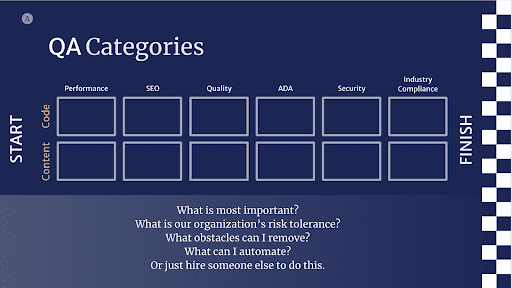3-Step Guide to Digital Marketing Quality Assurance
For marketers needing to keep their organizations ahead of the competition, the digital marketplace is a moving target. Overlook software updates or SEO guidelines, and your website will disappear from Google, lose compliance with regulatory guidelines, or simply break and lose vital functionality. Having an established digital marketing quality assurance process can help manage all the different aspects that make up your digital marketing efforts.
All these moving parts don’t just require time and skill to manage — they also cost money. Either you find a way to support the tools you need or you’ll lose customers because of lackluster site performance. If you don’t have a website that delivers results, technology is holding you back instead of allowing you to try new and bigger ideas.
You need a system that enables you to navigate these technical challenges so you can focus on developing innovative marketing approaches that move the needle for your business. Borrowed from software development, a quality assurance (QA) process allows your team to verify site improvements and minimize unnecessary errors. With the right testing system, you can keep moving at the pace of digital without worrying about breaking things.
But how should you start implementing a QA process?
The answer depends on your organization, its needs, and, ultimately, your resources. However, you can jumpstart your efforts to break free from so many technical difficulties by following these three steps.
How to Start Implementing a QA Process for Digital Marketing Quality Assurance
1. Analyze Site Activities Before Establishing QA Processes

Implementing a QA process to monitor your site’s many moving parts sounds complex for any marketer. But depending on your organization’s needs, you have multiple resources available that can minimize the technical challenges ahead.
QA tools for digital marketing assurance range from free, do-it-yourself plugins to comprehensive software-as-a-service (SaaS) platforms. The right choice for your needs ultimately depends on your site’s most consistent activities. Do you dedicate the bulk of your marketing toward publishing fresh content? Or does your site function as more of a tool that requires code changes and new features to be effective?
6 Website Priorities for a Marketer Implementing a QA Process
Once you’ve determined whether to focus on testing content or code, you can identify the right QA approach to suit your business. Though you have an assortment of tools at your disposal, you need to start with your areas of greatest need.
No matter whether your team is most often focused on updating code or content, both impact vital elements of your site. Marketing priorities that will be bolstered by an effective QA process fall under six interrelated categories:
- Performance: A site that loads slowly is frustrating for users who have grown dependent on websites to quickly serve their needs. But just as importantly, recent changes to Google’s Core Web Vitals have linked site performance with search rankings. If your site is slow, it will be harder for your prospective customers to find it in the first place.
- SEO: Put simply, your company’s website is invisible if it doesn’t rank highly in search results. QA tools such as Semrush will allow you to regularly monitor high-ranking search terms your customers are using. Plus, these tools will identify areas of your site that are potential problems for SEO.
- Quality: The quality of your site refers to coding or content errors that diminish site performance. Depending on your area of greatest need, you can use automated and DIY tools to monitor website quality.
- Accessibility: For many organizations, compliance with ADA guidelines to create an inclusive digital experience is legally required. Plus, failing to account for accessibility limits your audience while also impacting search results given Google’s Core Web Vitals are aligned with accessible design principles. Siteimprove is just one tool that monitors how code and content changes impact accessibility.
- Security: Seemingly every new day brings word of a business who was victimized by a data breach. Tools such as SonarQube will regularly scan your site for security vulnerabilities and other issues to protect your organization and its customers from risk.
- Industry Compliance: Depending on the demands of your industry, you can deploy specific QA tools to ensure that your site meets state or federal regulatory guidelines.

2. Identify Areas of Greatest Risk as Initial Candidates for a QA Process

Along with identifying whether your site activities most involve changes to content or code, you should evaluate which of the six areas above pose the most risk for your business.
If you work in the financial industry, security and compliance with regulations such as those involving transaction information and accessibility would be candidates for QA processes. Conversely, if your current site is especially fragile, code quality and performance would stand out as your areas of greatest need. Or if your site is especially complex, a visual regression testing tool such as Diffy would be useful for verifying no unexpected outcomes result from code changes.
With six aspects of your digital marketing demanding ongoing care, you can’t devote your resources to every area from the start and generate the results you need. Analyzing your most pressing needs is crucial to planning a QA process. From there, you can set up and share an internal document that outlines QA processes for code publishing or content changes. Continuous integration tools such as CircleCI also provide a way to automate a testing process when you deploy new code.
QA processes and continuous integration are historically more associated with software applications than digital marketing. Well, guess what: Modern websites are complex software applications. To mitigate the many risks associated with the consistent changes your site demands, you need to turn to lessons from the technology sector.
Once you’ve identified the areas where your organization is most at risk, you can apply QA tools that will allow your website to evolve with the needs of your organization in a reliable way. From that point forward, you gain a valuable tool for accelerating growth across your entire business.
3. Implement QA Processes by Mixing DIY Innovation and Outside Expertise

While many SaaS tools that perform QA tasks are user friendly, you didn’t get into marketing to manage code releases and software upgrades. Today’s marketplace leaves many CMOs feeling more like CTOs. But establishing a QA process enables you to focus on the marketing initiatives your organization needs rather than whatever part of your site needs work.
How to Start Developing a Digital Marketing Quality Assurance Plan
To manage the many technical demands of modern marketing, you need an agency with the expertise to implement the digital marketing quality assurance processes you need. At COLAB, we will empower you with tools that will make a difference for your business. We can assess your organization’s needs and eliminate the biggest barriers to your marketing success. Today’s marketing is simply too complex to manage without establishing the right framework. If you want to work from a foundation that’s fast, agile, and prevents errors before they happen contact us.

